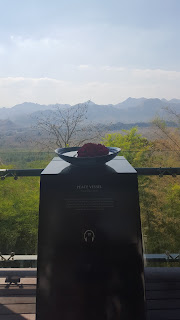Hellfire Pass is a historical war site in the mountains of Thailand. It's a place I never studied about in school or read about in a textbook, however the site is incredibly significant to the story of WWII. I spent four hours learning about the atrocities the POWs and Asian laborers endured while building the Thai Burma Railway, more commonly known as Hellfire Pass. The story below recounts the construction of the railway from 1942 through 1945 (as told by the official hellfire pass memorial museum).
A RAILWAY TO BURMA
In December 1941, the Pacific war began with the Japanese attack on pearl harbor, hawaii, and the invasion of malaya. By mid 1942, japanese forces were fighting the British in Burma, their ultimate aim being an offensive against india. To maintain their armies in Burma, the Japanese needed a more secure supply route than the vulnerable sea lanes between singapore and rangoon. They decided to construct a railway 415 km long through jungle and mountain from Ban Pong in Thailand to Thanbyuzayat in burma.
BUILDING THE RAILWAY
to build the railway the Japanese assembled a multinational workforce of approx 250,000 laborers and over 60,000 dutch, australian, British and american POWs. Work on the line in southern burma and in thailand began in Oct 1942. On 16 Oct 1943, the two ends of the burma thailand railway were joined at konkoita thailand.
Little modern equipment was available for railway work. Earth and rock were broken by shovels, picks and hoes and carried away in baskets. Embankments of stone and earth were heaped up by human endeavor. Cuttings were driven through rock by hand. Metal taps and sledgehammers were used to drill holes for explosives. Most of the bridges along the railway were timber trestle bridges made from timber cut in the surrounding jungle.
From April 1943 the work pace increased greatly as the Japanese strove to meet a proposed august deadline for conpletion. This was the notorious 'speedo' period. POWs and Asian laborers worked punishing 12 hour shifts well into the night. At Konyu Cutting the flickering bonfire light on the emaciated workers gave the place it's name- Hellfire Pass. The 'speedo' coincided with the wet season while cholera claimed thousands of lives.
Between Dec 1943 and Aug 1945 some 220,000 tons of nilitary supplies were carried over the railway. Allied air raids hindered the railways operation, yet the Japanese continued to move supplies along the route. Today 130 km of the line remain in use, from Non Pladuk to Namtok.
THE COST
Of the 60,000 allied POWs who worked on the railway, 12,399 died. Between 70,000 and 90,000 civilian laborers also died. The reasons for this appalling death toll were: lack of proper food, inadequate medical facilities and the brutal treatment from the guards and railway supervisors.
Rice, with a little dried vegetable and dried fish, was the basic food of the POW. This meager diet was supplemented to some extent through trade with local people. Starvation led to a range of diseases including beriberi and pellagra. Weakened POWs living in appalling conditions common fell ill to malaria, dysentery, cholera and tropical ulcers.
POWs lived in attap (woven palm thatch) and bamboo huts. Huts were overcrowded and cooking and sanitary arrangements at camps were primitive. Lack of clothing and footwear increased the risk of illness.
Physical punishment was a feature of Japanese military discipline and the POWs were often given severe beatings and other forms of punishment.
If anything, the asian laborers, or Romusha, as they were known, fared even worse. Unlike POWs, they had no army doctors to give them basic medical treatment.
'V' ORGANIZATION
thailand was a reluctant ally of Japan and allies interned citizens were well treated by the thais. Internees became aware of the plight of the POWs. An Internee group known as the V organization, aided by neutral businessmen and sympathetic thais, smuggled food and medicines to POWs.
PEACE AND AFTER
after the completion of the railway, the POWs were either kept in thailand or sent back to singapore. When the war ended the POW survivors were repatriated with proper food and medical treatment and many quickly recovered however most carried the mental scars of their experience with them the rest of their lives.
The POWs who died along the railway were reinterred at the Commonwealth war Graves commission cemeteries at Thanbyuzayat, kanchanaburi and chung kai. American dead were returned to the US.










Unbelievable what people can do to people. Thanks for sharing.
ReplyDeleteInteresting and disturbing account of yet another atrocity committed during WWII. I'm sure it was quite something to see
ReplyDeleteThat's pretty amazing!
ReplyDeleteAnd there's probably more that's been left out of the american history books.